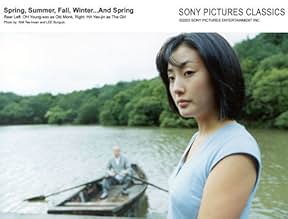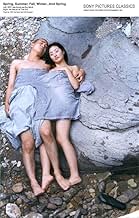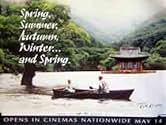Spring, Summer, Fall, Winter... and Spring
ओरिजिनल टाइटल: Bom yeoreum gaeul gyeoul geurigo bom
एक लड़के को पानी में स्थित एक पृथक मंदिर में एक बौद्ध साधू द्वारा पाला-पोसा जाता है, जहां साल मौसम की तरह गुजरते हैं।एक लड़के को पानी में स्थित एक पृथक मंदिर में एक बौद्ध साधू द्वारा पाला-पोसा जाता है, जहां साल मौसम की तरह गुजरते हैं।एक लड़के को पानी में स्थित एक पृथक मंदिर में एक बौद्ध साधू द्वारा पाला-पोसा जाता है, जहां साल मौसम की तरह गुजरते हैं।
- पुरस्कार
- 15 जीत और कुल 9 नामांकन
Oh Yeong-su
- Old Monk
- (as Young-soo Oh)
Seo Jae-kyeong
- Boy Monk
- (as Jae-kyeong Seo)
Ji Dae-han
- Detective Ji
- (as Dae-han Ji)
फ़ीचर्ड समीक्षाएं
At the risk of boring you all senseless here are some observations off the top of my head.
THE HUT Representing the self. All the possessions and shelter needed is on the floating hut. When the young man can no longer live at peace and comfort in the hut then bad things transpire. He never commits lustful acts in the hut. When we seek happiness outside ourselves, we are never truly content.
THE DOORS The doors by the lakeside and in the hut are symbolic rather than prescriptive. The fact there are no walls means their use is not forced but elected. They represent morality and discipline. Morality is not defined by a higher power but by society and the self. By adopting the constraints the doors engender, self-discipline is attained. As soon as the young man transgresses these self-imposed boundaries, to sneak across to the young woman, then disaster follows.
THE DEAD ANIMALS The Master allows the young boy to let the animals die. He does not become an all powerful father figure, cleaning up after him, but allows him to make mistakes and suffer the consequences. Buddhism does not have a higher power but rather promotes self-awareness.
THE MILLSTONE AND BUDDHA Represent the twin stones of regret for killing the fish and the snake. What you do unto others, you do unto yourself. He has carried that karma around with him all his life until he transcends them both, carrying them to the top of the hill, near heaven. Here he cuts himself free and attains redemption through struggle.
THE MASTER Is a great teacher, but does not lecture. Hardly a word is spoken, but lessons are learned. A good teacher points the way for a student to discover self-evident knowledge for themselves.
THE MOTHER The veil, representing guilt and shame are ultimately the cause of her downfall. Hiding from the outside world can bring about ruin.
THE YOUNG BOY Both at the beginning and the end, represents us. A good life is attained not by the absence of bad thoughts, but rather by their mastery, so they have no hold over us. We choose our behaviour rather than it choose us. The new boy is not born without sin, but rather must walk his own path to divinity. The same actor playing the young boy show the eternal cycle of the human soul.
THE SEASONS The endless cycle of birth, growth and death.
THE HUT Representing the self. All the possessions and shelter needed is on the floating hut. When the young man can no longer live at peace and comfort in the hut then bad things transpire. He never commits lustful acts in the hut. When we seek happiness outside ourselves, we are never truly content.
THE DOORS The doors by the lakeside and in the hut are symbolic rather than prescriptive. The fact there are no walls means their use is not forced but elected. They represent morality and discipline. Morality is not defined by a higher power but by society and the self. By adopting the constraints the doors engender, self-discipline is attained. As soon as the young man transgresses these self-imposed boundaries, to sneak across to the young woman, then disaster follows.
THE DEAD ANIMALS The Master allows the young boy to let the animals die. He does not become an all powerful father figure, cleaning up after him, but allows him to make mistakes and suffer the consequences. Buddhism does not have a higher power but rather promotes self-awareness.
THE MILLSTONE AND BUDDHA Represent the twin stones of regret for killing the fish and the snake. What you do unto others, you do unto yourself. He has carried that karma around with him all his life until he transcends them both, carrying them to the top of the hill, near heaven. Here he cuts himself free and attains redemption through struggle.
THE MASTER Is a great teacher, but does not lecture. Hardly a word is spoken, but lessons are learned. A good teacher points the way for a student to discover self-evident knowledge for themselves.
THE MOTHER The veil, representing guilt and shame are ultimately the cause of her downfall. Hiding from the outside world can bring about ruin.
THE YOUNG BOY Both at the beginning and the end, represents us. A good life is attained not by the absence of bad thoughts, but rather by their mastery, so they have no hold over us. We choose our behaviour rather than it choose us. The new boy is not born without sin, but rather must walk his own path to divinity. The same actor playing the young boy show the eternal cycle of the human soul.
THE SEASONS The endless cycle of birth, growth and death.
This is a hypnotic film to watch. The beauty of it lays in the simplicity in which it has been told. Director Ki-duk Kim's images feel like paintings by great masters.
This story about Karma and Buddist beliefs could have used a bit of trimming to make it more appealing, since at times it is too static. This is a film to stay away for those interested in fast action or special effects. No one is going to find them here. What the viewer will get is a feeling of well being and inner peace. The director seems to be teaching us a lesson in how anyone can achieve nirvana through self examination, meditation and doing good no matter to whom. Also, how cruelty, be it against a harmless animal, or a human being, will haunt those who transgress throughout life.
The acting blends in with the serene beauty of the temple in the middle of the lake, as we watch one season following another, as seen by the amazing cinematography by Dong-hyeon Baek.
This story about Karma and Buddist beliefs could have used a bit of trimming to make it more appealing, since at times it is too static. This is a film to stay away for those interested in fast action or special effects. No one is going to find them here. What the viewer will get is a feeling of well being and inner peace. The director seems to be teaching us a lesson in how anyone can achieve nirvana through self examination, meditation and doing good no matter to whom. Also, how cruelty, be it against a harmless animal, or a human being, will haunt those who transgress throughout life.
The acting blends in with the serene beauty of the temple in the middle of the lake, as we watch one season following another, as seen by the amazing cinematography by Dong-hyeon Baek.
I'm constantly amazed by the appearance of some seemingly off-the-wall piece of art that when you view it evokes a stunning effect. The simplicity of this film, its low-key action and pace, its visual surrealistic beauty, all interact to create an emotional impression that is long-lasting and thought-provoking. Korea has been somewhat slower to enter the international cinematic world and here is a film with actors whose names stir little or no recognition. For myself, who has enjoyed the Korean films I've seen before, it was a delightful surprise. The film itself is a wonderful tapestry of Korean Buddhist culture, with quiet visual beauty, simple moral themes and human passions put into a simple, homespun perspective. The remarkable natural setting which reflects the wide spectrum of Korea's seasons, which range from hot, sticky humid-fraught summers to icy, cold snow-bound winters, become a metaphor of life with unadorned figures, completely human in form. The old monk becomes a witness to the interplay of human qualities, without judgment yet with a complete and quiet moral presence. The foibles of child cruelty is met with a simple retribution which imparts a lasting lesson. Judgment is always withheld and warnings are given simply. The effect of all of this rings long and lasting, much like the impression of a delicate Korean silk print: simple in design with plain brush strokes and stylized representations of nature-- yet, lasting in impression, often to the point of being unforgettable. I buy few videos and DVDs, preferring to see things I really enjoyed again and again. But, I've ordered this one.
a film of about the cycles of life, about solitude and love, innocence, corruption and redemption. stunning cinematography. lots of allusions and metaphors, as you might expect from Korean cinema. contemplative.
the story appears to centre on the life of buddhist monks living on a floating house, but as the film progresses, one sees that this is a film about the constancy within change and renewal. The female characters are not the most positive roles, representing corruption and temptation, tho also providing the means for renewal.
There are some memorable scenes not least the house in winter and the knife writing scene, this is not for those seeking martial arts action,
personally i found it slipped into one of favourite films list.
the story appears to centre on the life of buddhist monks living on a floating house, but as the film progresses, one sees that this is a film about the constancy within change and renewal. The female characters are not the most positive roles, representing corruption and temptation, tho also providing the means for renewal.
There are some memorable scenes not least the house in winter and the knife writing scene, this is not for those seeking martial arts action,
personally i found it slipped into one of favourite films list.
Perfect Simplicity
My review of this film should end with those two words. However, the 10 line minimum requirement that IMDb requires of all reviews belies the differences between my world and the world shown to me in Spring, Summer, Fall, Winter and Spring. I understand why IMDb does not want 1000's of (apparently) useless two-word reviews in their database. However, I would hope that they could make an exception for this film.
Perfect: The film is as close to perfect as a film could get. No shot is presented to us, nor a line of dialog uttered that does not make us ponder and understand at the same time. The film is also beautiful. (Like the previous reviewer, I am a fan of Asian cinema and never tire of the stunning ability of Asian directors to capture beauty on film.) This film exceeds most other Asian films I have seen in the cinematography regard. However, its beauty is surprisingly deceptive. Like most great films, it surpasses the 'cinematography' level of beauty and delves into the beauty of existence through its story. For example, the Old Monk has a different pet during each 'season' of his life. This is not discussed by the characters nor shoved in our face by the director as would have been done if Hollywood had done this film. It is merely background we experience and come to understand. Two days after viewing the film, I am still finding new reflections in my mind that encompass the cinematography, the literal story and the underlying context of the film.
Simplicity: This film approaches a level of cinematic Haiku. While I don't recall the entire dialog with any specificity, I am sure you could print the script on one page of paper. The amazing part is that while you are watching the film, you don't notice this. Every shot moves the story along. The simplicity of life as shown by the story is reflected in the simplicity of the film. After the film ended, I had a strong urge to move away from civilization and live or die in peace with nature. I enjoy (and have come to be too dependent upon) modern inventions, so I will stay at home. However, this film will remain in my heart. It does exactly what good story-telling is supposed to do: Take us completely out of our world and put us in another. There is no wonder that this film was selected for so many film festivals.
My review of this film should end with those two words. However, the 10 line minimum requirement that IMDb requires of all reviews belies the differences between my world and the world shown to me in Spring, Summer, Fall, Winter and Spring. I understand why IMDb does not want 1000's of (apparently) useless two-word reviews in their database. However, I would hope that they could make an exception for this film.
Perfect: The film is as close to perfect as a film could get. No shot is presented to us, nor a line of dialog uttered that does not make us ponder and understand at the same time. The film is also beautiful. (Like the previous reviewer, I am a fan of Asian cinema and never tire of the stunning ability of Asian directors to capture beauty on film.) This film exceeds most other Asian films I have seen in the cinematography regard. However, its beauty is surprisingly deceptive. Like most great films, it surpasses the 'cinematography' level of beauty and delves into the beauty of existence through its story. For example, the Old Monk has a different pet during each 'season' of his life. This is not discussed by the characters nor shoved in our face by the director as would have been done if Hollywood had done this film. It is merely background we experience and come to understand. Two days after viewing the film, I am still finding new reflections in my mind that encompass the cinematography, the literal story and the underlying context of the film.
Simplicity: This film approaches a level of cinematic Haiku. While I don't recall the entire dialog with any specificity, I am sure you could print the script on one page of paper. The amazing part is that while you are watching the film, you don't notice this. Every shot moves the story along. The simplicity of life as shown by the story is reflected in the simplicity of the film. After the film ended, I had a strong urge to move away from civilization and live or die in peace with nature. I enjoy (and have come to be too dependent upon) modern inventions, so I will stay at home. However, this film will remain in my heart. It does exactly what good story-telling is supposed to do: Take us completely out of our world and put us in another. There is no wonder that this film was selected for so many film festivals.
क्या आपको पता है
- ट्रिवियाThe inscription on the floor is "The Heart Sutra", one of the most important Sutra of Mahayana Buddhism, written in literary Chinese.
- गूफ़When the young monk finishes inscribing the Heart Sutra on the floor and falls down exhausted, the inscriptions below him change between shots (even though he is lying motionless). In one shot, the inscriptions he is lying on have been painted; and as he wakes up, the paint is gone.
- इसके अलावा अन्य वर्जनThe local Korean version of this film is approximately 90 seconds longer than the International release; a sequence was removed near the end of the film (at about the 100-minute point). This is reflected in the DVD releases, as the Tartan R2 (UK) release and the Columbia/Tristar R1 (USA) release use the International cut of the film, while the Bitwin R3 (Korean) DVD uses the original cut.
- साउंडट्रैकJeongseon Arirang
Traditional
Performed by Kim Young Im
टॉप पसंद
रेटिंग देने के लिए साइन-इन करें और वैयक्तिकृत सुझावों के लिए वॉचलिस्ट करें
- How long is Spring, Summer, Fall, Winter... and Spring?Alexa द्वारा संचालित
- What is the Korean song played while the monk is climbing the mountain?
- What does the song mean that is played while the child monk ties a stone to the fish and the snake?
- What are the differences between the International Version and the Original Version?
विवरण
- रिलीज़ की तारीख़
- कंट्री ऑफ़ ओरिजिन
- आधिकारिक साइट
- भाषा
- इस रूप में भी जाना जाता है
- Bom Yeoareum Gaeul Gyeoul Geurigo Bom
- फ़िल्माने की जगहें
- उत्पादन कंपनियां
- IMDbPro पर और कंपनी क्रेडिट देखें
बॉक्स ऑफ़िस
- US और कनाडा में सकल
- $23,80,788
- US और कनाडा में पहले सप्ताह में कुल कमाई
- $42,561
- 4 अप्रैल 2004
- दुनिया भर में सकल
- $88,42,902
- चलने की अवधि1 घंटा 43 मिनट
- रंग
- ध्वनि मिश्रण
- पक्ष अनुपात
- 1.85 : 1
इस पेज में योगदान दें
किसी बदलाव का सुझाव दें या अनुपलब्ध कॉन्टेंट जोड़ें

टॉप गैप
By what name was Spring, Summer, Fall, Winter... and Spring (2003) officially released in Canada in French?
जवाब
































